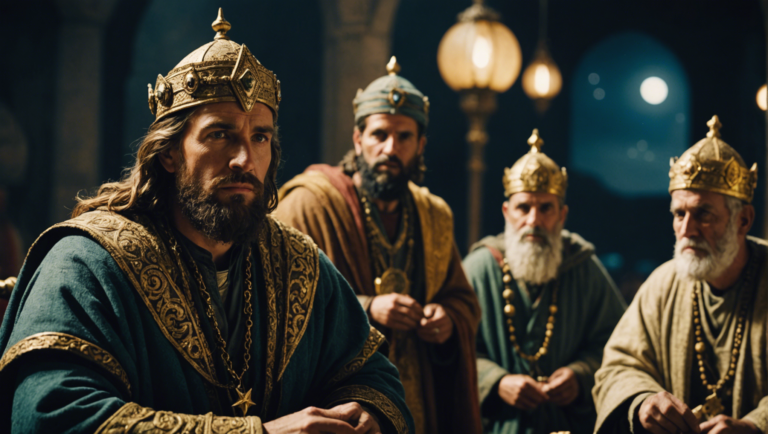What Astrological Sign Was Jesus
Exploring the Astrological Sign of Jesus: Debates and Insights
The figure of Jesus Christ is perhaps one of the most scrutinized and revered figures in history. Beyond theological inquiries, there lies a fascinating discussion within astrological circles about the astrological sign under which Jesus was born. While the Bible does not provide explicit dates or astrological details, scholars and astrologers have attempted to piece together clues to answer this enigmatic question.
Debates Over Jesus’s Birth Date
One of the primary sources of contention when determining Jesus’s astrological sign is the actual date of his birth. The traditional date of December 25th would place him under the sign of Capricorn. However, historians and biblical scholars argue that this date, adopted by the early Christian church, may not be historically accurate. Alternatives suggested range widely across the calendar, each proposing a different astrological sign for Jesus.
Insights from Historical and Astronomical Evidence
To uncover the astrological sign of Jesus, some experts turn to historical and astronomical evidence. Analysts have examined historical records, such as the reign of King Herod and the appearance of the "Star of Bethlehem," to narrow down possible dates. Astronomical software can now simulate the night sky over Bethlehem two millennia ago, offering clues to significant celestial events that could align with biblical descriptions.
Pisces: A Sign Resonant with Christian Symbolism
Among the various hypotheses, the suggestion that Jesus was a Pisces garners considerable attention. This theory is partly rooted in the symbolic resonance between the characteristics of Pisces and the teachings of Jesus. Pisces, represented by two fish swimming in opposite directions, echoes the fish symbolism prevalent in early Christianity. Additionally, the attributes of compassion, sacrifice, and sensitivity often associated with Pisces reflect many aspects of Jesus’s life and teachings.
The Case for Other Astrological Signs
However, the speculation doesn’t end with Pisces. Some conjectures point towards Virgo, a sign symbolizing purity and service, which aligns with the Virgin Birth narrative and Jesus’s life of service. Others propose Sagittarius, highlighting the sign’s association with spirituality, travel, and the search for truth, mirroring Jesus’s itinerant preaching. These interpretations showcase the rich tapestry of meanings that astrologers weave around historical figures.
Skepticism and Critique within the Astrological and Academic Communities
Skepticism abounds regarding the quest to pin down Jesus’s astrological sign. Critics argue that such endeavors may reflect more about contemporary interests in astrology than historical or theological truth. Academics caution against projecting modern astrological concepts onto ancient historical figures, emphasizing the vast differences in cultural and religious contexts.
The exploration of Jesus’s astrological sign remains a fascinating intersection of history, astronomy, and spirituality. While definitive answers may elude us, this inquiry speaks to the enduring human desire to understand significant historical figures not just through the lens of their actions and teachings, but also within the cosmic framework of their times. Whether one views Jesus as a Pisces, Capricorn, Virgo, or any other sign, this discussion invites a deeper reflection on the meanings we seek in the stars and in the stories of the past.
Historical Context: Aligning Biblical Events with Astrological Calendars
The enigmatic intertwining of biblical events with astrological calendars has long ignited the curiosity of scholars, theologians, and laypeople alike. This exploration delves into how these celestial mappings have historically aligned with scriptural narratives, offering a unique lens through which to view both astrology and the Bible.
Bridging the Celestial and the Scriptural
Astrology, with its roots deeply embedded in ancient civilizations, has historically served as a guide to understanding the seasons, forecasting events, and even determining divine inclinations. Theological texts, particularly the Bible, have also been scrutinized for potential astrological references, suggesting that the movements of celestial bodies were of considerable significance even in biblical times.
The quest to align biblical events with astrological calendars is not merely an academic exercise but an endeavor to understand how ancient peoples interpreted their place in the cosmos. It opens up inquiries into the Magi’s star in the Nativity story or the darkened sun at the Crucifixion, examining whether these narratives could correspond to known astronomical events.
Deciphering Celestial Symbols in Biblical Texts
The Bible is replete with references that some interpret as allusions to astrological phenomena. For instance, the Book of Joshua speaks of the sun and moon standing still, a narrative some propose could reference a significant celestial event. Similarly, the vivid imagery found in the Book of Revelation, with its stars, moons, and cosmic occurrences, has been viewed through an astrological lens, suggesting that these could symbolize deeper, perhaps even astrological, meanings.
Furthermore, the portrayal of the Virgin Mary under a starry cloak or the frequent depiction of fish in early Christian art has ignited debates about whether these could be linked to the astrological signs of Virgo and Pisces, respectively. These interpretations strive to unveil an interconnectedness between sacred texts and the heavens, suggesting a symbiotic relationship between spirituality and the stars.
Uncoding the Astrological Significance of Jesus’ Birth
A focal point of discussion is the astrological sign under which Jesus might have been born, a topic brimming with theological and astronomical implications. Some scholars suggest that the Star of Bethlehem, a pivotal symbol in the Nativity story, could be an astronomical event such as a conjunction of planets, a comet, or a supernova. Astrologically, this star purportedly heralded the birth of a king, marking a moment of cosmic significance that aligned with prophetic expectations.
The analysis of the timeline for Jesus’ birth, based on historical and astronomical data, points to potential astrological signs. Efforts to correlate this with specific celestial phenomena at the time include examining the alignment of Jupiter and Saturn in what is known in astrology as the Great Conjunction, believed by some to signal significant worldly events.
Navigating Through Ancient Texts and Celestial Patterns
The endeavor to map biblical narratives onto astrological calendars necessitates a multidisciplinary approach, blending theology, history, astronomy, and astrology. This synthesis allows for a comprehensive examination of ancient texts and celestial patterns, offering insights into how these might parallel or influence each other.
For instance, the Paschal Full Moon, which determines the date of Easter, is a direct connection between a biblical event and the lunar calendar. This illustrates how ancient calendars, guided by both solar and lunar cycles, were integral to scheduling religious observances, thus embedding astrological principles into the very fabric of biblical timekeeping.
Reflecting on the Convergence of Skies and Scriptures
The exploration of the relationship between biblical events and astrological calendars is not just an academic pursuit but a journey into understanding how humans across millennia have sought to make sense of the divine through the stars. This quest reflects a universal wonder at the cosmos, an attempt to decipher the greater design through both scripture and the celestial sphere.
The dialogue between the skies and the scriptures is ongoing, with each discovery offering new dimensions of understanding. This interdisciplinary exploration enriches our grasp of the past, inviting us to contemplate the cosmos and its connection to the spiritual narratives that have shaped human history.
The Influence of Astrology in Ancient Religious Texts
Unveiling the Stars: Astrology’s Role in Sacred Writings
Astrology, the ancient practice of interpreting the movements and relative positions of celestial bodies as a means to divine information about human affairs and terrestrial events, has woven its way through history, touching every culture and civilization in its path. This enigmatic and often misunderstood discipline holds a particularly fascinating relationship with the world’s ancient religious texts, shaping narratives and beliefs in profound ways.
The Celestial Blueprint of Ancient Faiths
To comprehend the extent of astrology’s influence on religious scriptures, one must first appreciate the historical and cultural context in which these texts were written. In times when science and religion were not distinct entities but intertwined threads of a single tapestry, the heavens served as a grand canvas upon which the mysteries of existence were projected. The stars and planets, in their everlasting dance, were seen not just as luminous objects in the night sky but as divine messengers bearing news of destiny and divine will.
In ancient Mesopotamia, the cradle of astrology, priests and scholars observed the skies, recording the movements of planets and stars. These celestial observations laid down the foundations for both astronomical knowledge and astrological interpretations, greatly influencing the religious and philosophical texts of the time. The Enuma Elish, the Babylonian creation epic, offers subtle references to celestial bodies and their significances, embedding astrology into the very fabric of creation myths.
Zodiac Signs and Biblical Narratives
One cannot discuss astrology’s imprint on ancient sacred writings without addressing the intriguing question of "what astrological sign was Jesus?" This inquiry, albeit modern, highlights the curiosity and eagerness to uncover astrological underpinnings within biblical texts. The Bible, particularly the Old Testament, is replete with astrological references and imagery, from the story of the Star of Bethlehem heralding Jesus’s birth to the numerous mentions of the sun, moon, and stars in metaphorical contexts.
Scholars and theologians have long debated the presence and relevance of astrology in the Bible. While direct references to astrological signs in the context we understand today are sparse, the symbolic use of celestial phenomena suggests an underlying astrological knowledge. The Magi, or Wise Men, following a star to find the newborn Jesus, is perhaps the most direct indication of astrology in the New Testament, marrying the mystical with the divine.
Astrological Imprints on Eastern Philosophies
Moving eastward, the Vedas—ancient sacred texts of Hinduism—offer a rich tapestry of celestial lore. Vedic astrology, or Jyotish Shastra, is an integral part of these texts, emphasizing the influence of planets and stars on human life and events. Unlike its Western counterpart, Vedic astrology is deeply woven into the religious and philosophical narratives of Hinduism, illustrating a harmonious blend of the celestial and the spiritual.
The Stars in Islamic Tradition
Islamic texts, too, exhibit a nuanced relationship with astrology. While the Quran explicitly warns against divining precise future events from the stars, it acknowledges their creation by Allah for signs and navigation. This duality reflects the broader Islamic view of astrology: a recognition of the stars’ significance in the divine order, tempered by a condemnation of their use for fortune-telling or divination that contradicts divine decree.
Reflecting on the Cosmic Influence
The exploration of astrology’s influence on ancient religious texts reveals a profound interconnectedness between the heavens and human spirituality. These sacred writings, regardless of their geographic or cultural origins, recognize the cosmos as a source of wisdom and guidance. They offer a celestial narrative that complements earthly existence, inviting believers to contemplate the divine orchestration of the universe.
As modern readers and interpreters of these ancient texts, the challenge lies in discerning the historical from the mystical, the astrological from the astronomical. The enduring fascination with astrology, embodied in questions like the astrological sign of Jesus, underscores a universal desire to find meaning in the stars—a testament to astrology’s lasting legacy in shaping spiritual narratives across civilizations.
The Star of Bethlehem: Astronomical Phenomenon or Astrological Symbol?
One of the most enduring and fascinating aspects of the Nativity story is the tale of the Star of Bethlehem. It is described in the Gospel of Matthew as a celestial sign that guided the Magi, or wise men, to the birthplace of Jesus. The nature of this star has been a subject of debate for centuries: was it an actual astronomical event or does its significance lie purely in the astrological realm? Let’s delve into the evidence and theories that surround this enigmatic star.
Exploring Historical and Astronomical Records
To understand the Star of Bethlehem, it’s essential to examine historical and astronomical records from the period. Ancient astronomers from various civilizations meticulously documented celestial events, providing a potential goldmine of information. Scholars have scoured these records, looking for anomalies that could explain the star’s appearance.
A popular theory posits that the star was a conjunction of planets, an event where planets align in the sky, creating a bright, star-like effect. Historical records indicate that around the time of Jesus’s birth, there was a notable conjunction between Jupiter and Saturn. This rare occurrence would have been significant for astrologers of the time, possibly interpreted as a portent of great change.
Delving into Astrological Significance
Astrology played a pivotal role in the ancient world, guiding everything from personal decisions to the interpretation of national events. The astrological symbolism of a celestial event could imbue it with meaning beyond its physical manifestation.
Jupiter, known as the "King Planet," represented kingship and authority, while Saturn was associated with protection and Israel. Their conjunction in the constellation of Pisces, a sign often linked with the Jewish people, could have been seen as a powerful omen signaling the birth of a significant figure in Judea.
Considering Other Celestial Phenomena
Beyond planetary conjunctions, other celestial events have been proposed as explanations for the Star of Bethlehem. Comets, supernovae, and even rare atmospheric phenomena have all been suggested. Each theory has its merits and challenges, ranging from the timing of these events to their visibility from the Middle East.
Comets, for example, were traditionally viewed as harbingers of doom, which makes them less likely candidates for symbolizing the birth of a divine king. Supernovae offer a more plausible explanation, as they create new "stars" that can shine brightly for weeks or months. However, the lack of corroborating historical records from the period makes this explanation contentious.
Theological and Symbolic Interpretations
For many, the value of the Star of Bethlehem story lies in its theological and symbolic meanings rather than its historical or scientific accuracy. The star represents divine intervention in the natural world, guiding individuals to find Jesus. It symbolizes light piercing through darkness, guiding those who seek truth.
This interpretation allows for a broader understanding of the story, one that transcends literal historical events. It elevates the star from a mere astronomical or astrological phenomenon to a symbol of hope, guidance, and revelation.
Navigating Between Science and Faith
The debate over the nature of the Star of Bethlehem encapsulates a broader dialogue between science and faith. It demonstrates how historical, astronomical, and astrological analyses can offer insights into religious texts, enriching our understanding of them.
However, it also highlights the limitations of relying solely on empirical evidence to explain phenomena deeply embedded in faith traditions. For many, the significance of the Star of Bethlehem isn’t in its physical reality but in the spiritual truths it signifies.
The Star of Bethlehem continues to fascinate because it resides at the intersection of science, history, and faith. Whether as an astronomical event, an astrological symbol, or a theological metaphor, it remains a potent symbol of the Nativity story’s enduring appeal. As we continue to explore its mysteries, it invites us to reflect on the ways in which the heavens have inspired awe and wonder throughout human history.
Modern Perspectives on Astrology and Christianity: A Coexisting View
Exploring the Intersection of Astrology and Christianity
Blending the Cosmic and the Divine
In an era marked by an expanding universal consciousness, the dialogue between astrology and Christianity has evolved significantly. Traditionally perceived as conflicting or mutually exclusive realms, modern perspectives suggest a more harmonious coexistence, where both astrology and Christianity can offer enriching insights into the human experience. This synthesis invites a deeper understanding of spirituality, where the cosmos and the divine are seen as interconnected aspects of the same existential inquiry.
The Historical Context and Modern Shifts
Astrology, with its roots stretching back to ancient civilizations, has always been a part of humanity’s quest to understand the mysteries of existence and the cosmos. Christianity, emerging two millennia ago, has shaped the spiritual and moral landscape of billions around the globe. Historically, the Christian Church has often viewed astrology with skepticism, if not outright condemnation, citing concerns over fatalism and idolatry. Yet, the modern spiritual seeker tends to navigate beyond traditional dogmas, seeking a spirituality that embraces a broader spectrum of human experience.
Recent discussions among theologians, scholars, and spiritual seekers illuminate a growing recognition of astrology’s value in understanding the Divine’s manifestations through the natural world. This shift is partly influenced by an increased appreciation for the symbolic and metaphysical dimensions of existence, where the language of astrology offers unique insights into the human psyche and spiritual journey.
Astrology as a Language of Creation
Astrology, approached from a contemporary spiritual perspective, is often seen not as a deterministic forecast of events but as a symbolic language that connects individuals to broader cosmic rhythms. This linguistic framework posits that celestial movements reflect divine orchestrations, offering a mirror to the soul’s evolution and the unfolding of divine will on Earth.
Christian mystics and some modern theologians have explored astrological symbolism within a Christian context, suggesting that celestial bodies, as part of God’s creation, hold significance in understanding God’s intentions and temporal cycles. This view encourages a reading of the heavens that resonates with the Christian search for wisdom and communion with the Creator.
Navigating the Challenges
While integrating astrology into a Christian spiritual framework presents rich possibilities for expansive spiritual narratives, it also poses significant challenges. The primary hurdle is overcoming centuries of doctrinal positions that categorically reject astrology. This requires a nuanced understanding of scriptures and Christian teachings, emphasizing a metaphorical and allegorical interpretation over a literal one.
Furthermore, advocating for a place for astrology within Christianity calls for a delicate balance between respect for traditional Christian beliefs and openness to metaphysical insights. This dialogue invites a reevaluation of the nature of divinity, free will, and the role of humanity in the cosmos.
Embracing a Multifaceted Spiritual Journey
For those exploring the confluence of astrology and Christianity, the journey is deeply personal and inherently multifaceted. It involves wrestling with philosophical questions, reinterpreting ancient wisdom, and finding personal resonance within the broader cosmic narrative. This path does not necessarily dilute Christian faith but rather seeks to enrich and deepen it by acknowledging the myriad ways the Divine can speak to and guide humanity.
As society progresses, the conversation around astrology and Christianity will likely continue to evolve, reflecting the growing desire for a spirituality that acknowledges the vastness of human experience and the mysteries of the universe. By fostering dialogue, education, and open-minded exploration, individuals can navigate this complex terrain, discovering new ways to express and experience their faith in a cosmos filled with wonder, wisdom, and divine presence.
This exploration into the blending of astrological and Christian perspectives invites a broader understanding of spirituality, one that transcends traditional boundaries and opens new avenues for divine encounter and understanding.
Conclusion
Diving deeply into the astrological sign of Jesus presents a rich tapestry of debates and insights, navigating through historical contexts, astrological calendars, and the intertwining of ancient beliefs with celestial phenomena. This exploration traverses through the significant nuances of aligning biblical events with astrological insights, revealing a complex relationship between the heavens and scripture that has fascinated scholars and believers alike for centuries.
The examination of historical contexts and astrological calendars uncovers a fascinating intersection of faith and astrology, suggesting that ancient people, including those in biblical times, may have viewed celestial events as deeply symbolic and intrinsically linked to divine narratives. This connection between significant biblical events and astrology opens a door to understanding the ancient world in a way that combines both faith and the science of the stars, challenging modern perceptions of a strict dichotomy between the two.
Astrology’s presence in ancient religious texts further enriches this conversation, illustrating how celestial bodies were often seen as heralds of divine messages or significant earthly events. The inclusion and discussion of astrological concepts within these sacred texts demonstrate that astrology was not merely a cultural backdrop but a component of spiritual life and understanding. This perspective invites a broader reflection on how ancient civilizations navigated their relationship with the cosmos and the divine, offering complex layers of interpretation that extend beyond a simplistic reading of these documents.
The enigmatic Star of Bethlehem stands at the crossroads of astronomical phenomena and astrological symbolism, embodying the persistent human quest to find meaning in the stars. Debates around whether this was a literal astronomical event, an astrological symbol, or a blend of both, reflect broader questions about the role of celestial phenomena in religious narratives. This exploration urges a reconsideration of how we interpret the convergence of astronomy, astrology, and theology, inviting a nuanced understanding that respects the depth of ancient astrological knowledge and its potential spiritual significance.
Modern perspectives on astrology and Christianity, advocating for a coexisting view, highlight a growing appreciation for the rich tapestry of human belief and knowledge systems. This stance encourages dialogue and exploration across seemingly disparate fields, recognizing that the division between science and faith, astrology and religion, is more permeable than previously thought. It champions a holistic view of human spirituality and understanding, acknowledging that the ancient practice of astrology can offer meaningful insights into biblical events and figures, bridging historical cultures and modern beliefs.
As this exploration unfolds, it becomes evident that the astrological sign of Jesus—a topic that initially seems to belong more to the realm of curiosity than serious theological or astrological study—serves as a microcosm for broader discussions about the integration of celestial symbolism with religious belief. This inquiry does not seek to redefine Christian faith through the lens of astrology, nor does it aim to demystify the divine with the stars. Instead, it encourages a richer, more inclusive understanding of how humanity has sought to understand the divine and our place under the heavens.
This complex interplay of astrology, religion, and history invites believers, scholars, and the curious alike to reflect on the multifaceted ways humanity has sought to make sense of the divine narrative. Whether through the alignment of starry constellations or the interpretation of ancient texts, the quest to understand Jesus’s place in the cosmos is more than an academic exercise; it is a journey into the heart of human belief, combining faith with the wonder of the universe. Thus, the discussion does not end with a conclusive astrological sign for Jesus but rather opens a multitude of pathways for further exploration, dialogue, and understanding, bridging past and present, earth and sky, human and divine.







